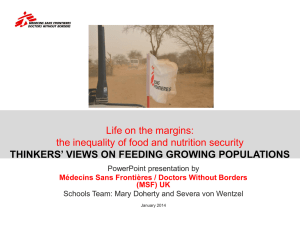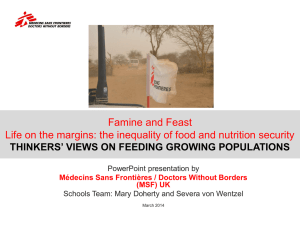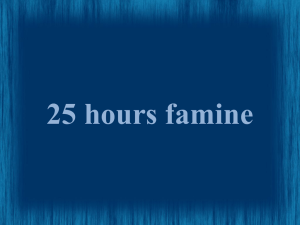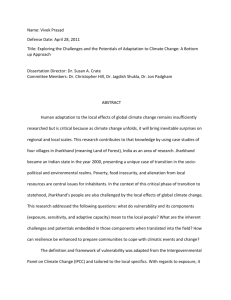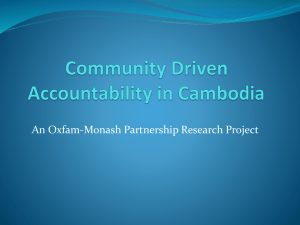understanding the entitlement approach to famine
advertisement
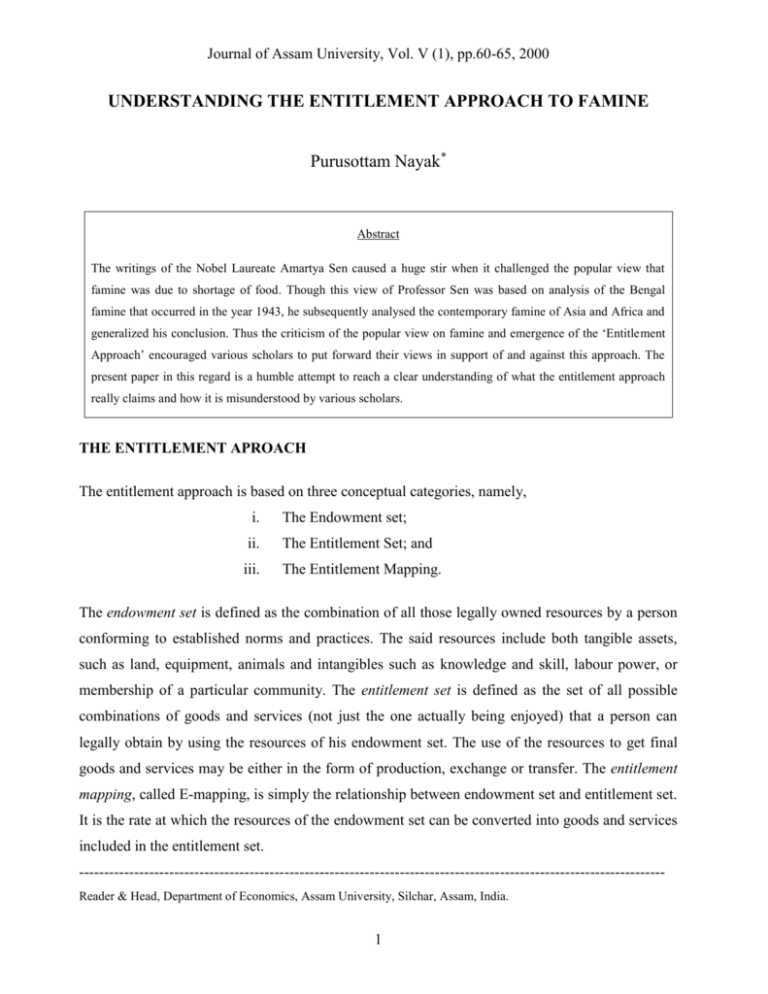
Journal of Assam University, Vol. V (1), pp.60-65, 2000 UNDERSTANDING THE ENTITLEMENT APPROACH TO FAMINE Purusottam Nayak* Abstract The writings of the Nobel Laureate Amartya Sen caused a huge stir when it challenged the popular view that famine was due to shortage of food. Though this view of Professor Sen was based on analysis of the Bengal famine that occurred in the year 1943, he subsequently analysed the contemporary famine of Asia and Africa and generalized his conclusion. Thus the criticism of the popular view on famine and emergence of the ‘Entitlement Approach’ encouraged various scholars to put forward their views in support of and against this approach. The present paper in this regard is a humble attempt to reach a clear understanding of what the entitlement approach really claims and how it is misunderstood by various scholars. THE ENTITLEMENT APROACH The entitlement approach is based on three conceptual categories, namely, i. The Endowment set; ii. The Entitlement Set; and iii. The Entitlement Mapping. The endowment set is defined as the combination of all those legally owned resources by a person conforming to established norms and practices. The said resources include both tangible assets, such as land, equipment, animals and intangibles such as knowledge and skill, labour power, or membership of a particular community. The entitlement set is defined as the set of all possible combinations of goods and services (not just the one actually being enjoyed) that a person can legally obtain by using the resources of his endowment set. The use of the resources to get final goods and services may be either in the form of production, exchange or transfer. The entitlement mapping, called E-mapping, is simply the relationship between endowment set and entitlement set. It is the rate at which the resources of the endowment set can be converted into goods and services included in the entitlement set. --------------------------------------------------------------------------------------------------------------------Reader & Head, Department of Economics, Assam University, Silchar, Assam, India. 1 Journal of Assam University, Vol. V (1), pp.60-65, 2000 According to Sen, famine is caused due to shortage of food but due to failure of entitlement. A person suffers from failure of food entitlement when his entitlement set does not contain enough food to enable him to avoid starvation in the absence of non-entitlement transfers, such as charity. Thus famine occurs. Since entitlement set is derived by applying E-mapping on the endowment set, the entitlement failure and thus famine can occur only through some adverse change either in endowment or E-mapping or both. Thus there are two types of famines- one is caused due to change in endowment and the other due to change in E-mapping. Analysis of famine can also be done in slightly different manner. As we know that Emapping consists of three different kinds of relations such as production, exchange and transfer, we can distinguish four types of famines caused due to either of the following reasons: 1. Endowment Loss; 2. Failure of Production; 3. Exchange Failure; and 4. Transfer Failure. Let us take the example of a fisherman who loses his boat. It is a case of loss of endowment and thus prevents the fisherman from catching the fish. The same fisherman without losing boat may also face the problem of catching fish in the adequate amount to be exchanged for the minimum amount of food that he needs. In the third case, the fisherman neither loses his boat, nor has inadequate fish, but faces the problem of getting minimum food due to relative fall in price of fish. In the last case the person fails to aid in the absence of endowment and not being a producer or exchanger. MISUNDERSTANDING SEN’S CONCEPTUAL FRAMEWORK The concept of entitlement as understood by Sen in the year 1977 has undergone some changes in the course of time. It has almost taken a newer framework which is not only more complete but also consistent (Sen, 1981 b). This change in conceptual framework from 1977 to 1981 has gone largely unnoticed by economists because of which many criticisms have become unwarranted. While advocating entitlement approach Sen understood the concept in terms of exchange entitlement without using the qualifier exchange. Accordingly he described famine as the failure of exchange entitlement (FEE). This type of formulation of the approach implies some restrictions on the concept of FEE. On the other hand, starvation caused by the loss of assets does 2 Journal of Assam University, Vol. V (1), pp.60-65, 2000 not qualify as a case of FEE, on the other; starvation offered by the direct producers of food as a result of crop failure does not count as FEE. Thus some categories of famine are not being able to be explained by the entitlement approach. But in the later writings of Sen (1981 a & 1981 b) production was explicitly included along with exchange and transfer in the definition of mapping. Besides, two new terms were employed to refer to set and mapping. These two terms as used by Dreze and Sen (1989) are now described as entitlement while the mapping is described by exchange entitlement or exchange entitlement mapping or E-mapping. Accordingly the latest position of the concept of famine is entitlement failure rather than exchange entitlement failure as in the past. THE ENTITLEMENT APPROACH TO FAMINE Survey of literature reveals that there are three different alternative interpretations given to entitlement approach. They are as follows: 1. Specific Hypothesis; 2. General Hypothesis; and 3. General Framework. The specific hypothesis places the entitlement approach in direct contradiction with the popular notion that famines are caused by reduced availability of food. The general hypothesis by contrast, does not deny that famines can be caused by food availability decline (FAD). Instead, the general hypothesis insists on three things as follows: i. Decline in food availability plays a role mainly by worsening the entitlement mapping of a person through rise in price of food; ii. Famine caused not due to FAD but due to inflationary situation fuelled by excessive monetary expansion; and iii. By worsening the entitlement mapping as opposed to depleting the endowment set. According to the third interpretation the rationale of the entitlement approach is neither to suggest nor to deny any particular hypothesis about the causes of famines, but to direct the search for causes into two broad channels, one involving the endowment set and the other involving the entitlement mapping. That is why the entitlement approach is essentially a framework of analysis. 3 Journal of Assam University, Vol. V (1), pp.60-65, 2000 THE CONTROVERSY OF FAD ANF FEE Sen actually made a contest between entitlement approach and the FAD approach but not between entitlement hypothesis and the FAD hypothesis. But this was misunderstood by many including one of the sympathetic commentator, Reuttinger (1984, p.885). In his own word, “Sen himself, has overreacted to the excesses of those who hold that famines are caused by a food availability decline”. There is a difference between these FAD hypothesis and FAD approach. The distinction between these two is the one between specific and the general. Sen vehemently denied the FAD approach and preferred the entitlement approach mainly because of two reasons as follows: 1. Plurality of Causes: There are many causes of famines. It can also occur in the absence of decline in food availability. The entitlement approach is in a position to identify these causes, which the FAD approach will have no clue about it. 2. Asymmetry of Impact: Whatever may be the cause of famine, its degree of impact felt on different sections of society are different. Thus, FAD approach does not supply any information in this regard whereas entitlement approach explains such asymmetries by looking separately at the entitlement sets of different socio-economic groups. Sen also through his four case studies in poverty and famines attempted to show that FAD hypothesis did not hold. Sen was misunderstood because his commentators felt that he was proposing entitlement hypothesis as an alternative to FAD hypothesis. This confusion was created because many of the commentators could not make a distinction between approach and hypothesis. All these led to a good deal of misplaced criticism of the entitlement approach. A related confusion that also existed is evident from the following statement of Baulch. According to him, “Sen’s immediate aim throughout Poverty and Famines is to discredit the traditional supply-side views of famines, which he labels the Food Availability Decline (or FAD) approach….” (Baulch, 1987, p.15). But if we examine carefully the entitlement approach, it reveals that it is not all against the supply side. Rather this approach insists that the supply-side effects ought to be analysed not in terms of aggregate food availability but in terms of entitlement sets of different socio-economic groups. 4 Journal of Assam University, Vol. V (1), pp.60-65, 2000 While doing so it does not restrict the supply-demand considerations to food market alone but to all related markets calling for the use of the general equilibrium method. The above discussion leads us to infer that the entitlement approach to famine as proposed by Sen does not offer any hypothesis- either specific or general about the causes of famine. When he said that famine was caused due to entitlement failure, he did not actually establish the causaleffect relationship between entitlement failure and famine instead he made a definitional statement. But it is true that he attempted to propose a general approach i.e., organizational framework for analyzing famines. He explored the causes of entitlement failure by undertaking a disaggregated analysis of entitlement sets of different socio-economic groups. The entitlement approach denied the fact that the famines are necessarily preceded by availability of food decline. In other words, it denied the necessity of FAD hypothesis. It also denied the usefulness of the FAD approach. However, the entitlement approach subsumed the FAD hypothesis but rejected the FAD approach. Finally, Sen claimed the superiority of the entitlement approach over FAD approach on the grounds of plurality of causes and asymmetry of impact. CRITICAL APPRAISAL OF ENTITLEMENT APPROACH The entitlement approach of famine has been looked at from various angles by research workers. A number of criticisms have been raised. Some of the important criticisms which are worth mentioning are evaluated in the following paragraphs: Several authors including Alamgir (1980), Bowbrick (1986) and Goswami (1990) contested Sen’s claim that some of the major famines such as Bengal Famine of 1943 and the African Famine of the 1970 that Sen examined were of non-FAD origin. In a much extended debate with Sen, Bowbrick has claimed to have refuted Sen’s diagnosis of the great Bengal Famine. According to him, famines cannot be discussed without taking into account aggregate food supply. In case of 1st degree shortage of food, widespread starvation can be avoided by proper redistribution but in case of 2nd and 3rd degree shortages redistribution in no way can solve the problem of starvation. In a subsisting economy famine may very well occur even in 1 st degree shortage owing to practical constraints on redistribution. Bowbrick also contends that the entitlement theory of Sen fails to recommend food inputs by focusing exclusively on distribution and ignoring aggregate shortage. Devereux (1988) cited the example of the famine of Wollo province in Ethiopia which occurred in the years 1972-74 to criticize the entitlement approach. He contended that this famine had the elements of both FAD and FED (food entitlement decline). He 5 Journal of Assam University, Vol. V (1), pp.60-65, 2000 said that the richer of the famine victims were being affected by FAD and the poorer by FED. Kula (1988 & 1989) misinterpreted the entitlement approach as a specific hypothesis by wrongly identifying entitlement with money income. He cited the example of Chinese Famine of 1959-61 and said that the urban people who had higher incomes in comparison to rural people suffered more in the absence of sufficient food. However, Kula failed to note that higher money income does not mean higher entitlement if the income cannot be translated into command over food. Rangaswami (1985) states that Sen by accepting famine to be widespread starvation and high mortality has accepted the common definition of famine and has focused his attention to the very end of a process but not the whole of the process leading to famine. Thus, according to her, Sen’s work based on such a terminal process is inadequate. She also said that the late nineteenth century literature of Indian famine such as the reports of Famine Enquiry Commissions (FECs) present a rich picture of contemporary famines and by the spirit, if not by the language, is based on the entitlement approach. According to her, the reports are nothing but the FAD view of famine. By pointing this fact she only can claim to be precursor of Sen’s thought though partially true. Pattanaik (1991) agreed that shortages in short period may be unimportant for explaining famines, but it would be a grave error to ignore long term decline in food availability. De Wall (1990) cited the famine of Sudan in Africa to criticize the entitlement approach. He said that people in Sudan chose to starve in the short run which could have been minimized if they had decided to trade assets for foods. But these starved people preserved their productive assets for the future even at the cost of great temporary distress. He also gave another explanation by saying that command over food cannot explain a lot of what happens during a famine. He laid stress on the effects of social disruptions related to wars on morbidity and mortality. According to him, the entitlement approach remains an inadequate approach in explaining the associated factors accompanied with war like mass migration, unhygienic living conditions and the outbreak of disease etc in a famine. Ashok Mitra (1982) who is a genuinely hostile critic of Sen added to the criticisms by saying that Sen did not add anything new in the concepts and deliberately tried to hide the ugly truths behind poverty and starvation by presenting his old ideas in a new garb. His concept, for instance, endowment sets are a close relative of the distribution of property and incomes. This type of view of Mitra is a crudely reductionism view and thus need not be taken seriously. 6 Journal of Assam University, Vol. V (1), pp.60-65, 2000 CONCLUSIONS The entitlement approach of famine is advocated by Amartya Sen does not offer any hypothesis- either specific or general about the causes of famine. Entitlement failure and famine is not really meant to be a causal statement but a definitional one. Sen was rather proposing a general approach, i.e., an organizational framework for analyzing famines. His analysis does not deny that famines can sometimes be caused by food availability decline. However, he denies the necessity of the FAD hypothesis and altogether denies the usefulness of the FAD approach. His entitlement approach subsumes the FAD hypothesis but rejects the FAD approach. The criticisms raised were mainly because of the misunderstandings of one sort or the other. In fact, Sen was trying to substitute one approach for another but not one hypothesis for another. At least in part, the root of misunderstanding might have been due to the restrictive nature of Sen’s original formulation of the approach. But Sen’s exploration of plurality in causes of famines constitutes his advance over thinking and hence comfortably survives all the criticisms. REFERENCES 1. Alamgir, M. (1980): Famine in South Asia: Political Economy of Mass Starvation, Gunn and Hain, Massachusetts. 2. Basu, D.R. (1986): “Sen’s Analysis of Famine: A Critique”, Journal of Development Studies, Vol. 22, pp. 593-603. 3. Baulch, B. (1987): “Entitlements and Wollo Famine of 1982-85”, Disasters, Vol. 11, pp. 195-204. 4. Bowbrick, P. (1986): “The Causes of Famine: A Refutation of Professor Sen’s Theory”, Food Policy, Vol. 11, pp. 105-124. 5. De Wall, A. (1990): “A Reassessment of Entitlement Theory in the Light of Recent Famines in Africa”, Development and Change, Vol. 21, pp. 469-490. 6. Devereux, S. (1988): “Entitlement, Food Availability and Famine: A Revisionist View”, Food Policy, Vol. 13, pp. 270-282. 7. Dréze, J. and Sen, A.K. (1989): Hunger and Public Action, WIDER Studies in Developing Countries, Clarendon Press, Oxford. 7 Journal of Assam University, Vol. V (1), pp.60-65, 2000 8. Goswami, O. (1990): “The Bengal Famine of 1943: Reexamining the Data”, Indian Economic Social History Review, Vol. 27, pp. 445-463. 9. Kula, E. (1988): “The Inadequacy of the Entitlement Approach to Explain and Remedy Famines”, Journal of Development Studies, Vol. 25, pp. 112-117. 10. ----------- (1989): “Politics, Economics, Agriculture and Famines: The Chinese Case”, Food Policy, Vol. 14, pp. 13-16. 11. Mitra, A. (1982): “The Meaning of Meaning”, Economic and Political Weekly (Reviews), Vol. 27, March. 12. Pattanaik, U. (1991): “Food Availability Decline and Famine: A Longer View”, Journal of Peasant Studies, Vol. 19, pp. 1-25. 13. Rangaswami, A. (1985): “Failure of Exchange Entitlements on Theory of Famine: A Response”, Economic and Political Weekly, 12 & 19 October. 14. Reuttinger, S. (1984): “Review of Sen (1981 b)”, Economic Development and Cultural Change, Vol. 32, pp. 881-886. 15. Sen, A.K. (1976): “Famines as Failures of Exchange Entitlements”, Economic and Political Weekly, Special Number, August. 16. ------------ (1977): “Starvation and Exchange Entitlements: A General Approach and its Application to the Great Bengal Famine”, Cambridge Journal of Economics, Vol. 1, pp. 3353. 17. ------------- (1981a): “Ingredients of Famine Analysis: Availability and Entitlements”, Quarterly Journal of Economics, Vol. 95, pp. 433-464. 18. ------------- (1981b): Poverty and Famines: An Essay on Entitlement and Deprivation, Clarendon Press, Oxford. ----------------0---------------- 8
